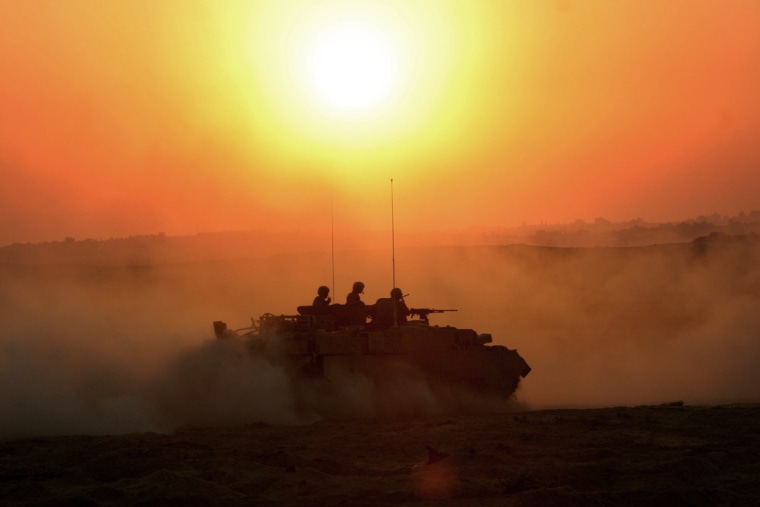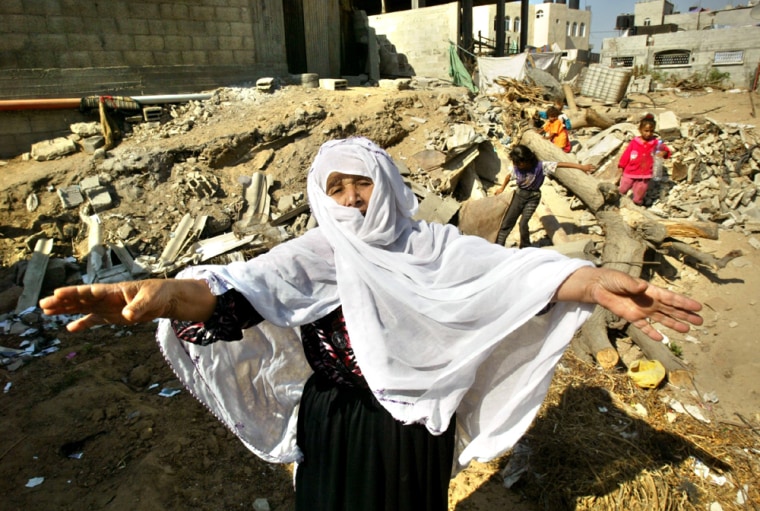By day, the streets of this densely populated Palestinian labyrinth are jammed with seething funeral processions and solemn mourning tents. But gradually, long before dusk, the camp is transformed into a ghost town, with civilians cowering in their apartments and masked gunmen darting through the shadows carrying Kalashnikov assault rifles and homemade bombs.
"We just hug the children and cover them with clothes and blankets to protect them from the bullets," said Ama Motawaq, 59, a resident of the camp whose windows have been shattered and walls pockmarked by bullets.
On Thursday evening, the boom of Israeli Merkava tank cannons and the staccato crackle of heavy-caliber machine-gun fire ricocheted through the concrete alleyways, heralding the 10th night of Israel's most lethal incursion into the Palestinian territories in nearly 2 1/2 years.
Ninety-four Palestinians and five Israelis have been killed, according to statistics provided by each side in the conflict, since Israeli forces entered the northern Gaza Strip in an operation aimed at preventing Palestinian guerrillas from firing rockets and mortars at Jewish settlements and Israeli towns over the border. The fighting has pitted a sophisticated, high-tech military force against guerrillas using assault rifles, grenade launchers and weapons crafted from common explosives, construction site scraps and party balloons.
Differing accounts
On Thursday morning, Israeli intelligence officers watching video beamed from an unmanned surveillance aircraft saw two militants trying to launch a rocket into Israel, according to a military spokeswoman. Palestinian doctors and nurses peering out a window at the same two figures said they saw something very different: two boys playing with pipes and sticks in a sandy lot next to a school.
Seconds later, a missile tore Suleiman Abu Foul, 12, and Raed Abu Zeid, 15, to shreds.
Manar Farra, director of the Al Awda Hospital on the northern edge of the Jabalya camp and one of the witnesses to the incident, said the younger boy was brought to the hospital "without a head. Even his family could not recognize him. It made us hate our profession. We could do nothing."
At almost the same moment, just after 8:30 a.m., Palestinians fired two crude Qassam rockets into the Israeli town of Sderot, about two miles from the Gaza border. No one was killed, but it was the kind of attack that had spurred Israel's leaders to send an estimated 200 tanks and armored personnel carriers and 2,000 soldiers into the Gaza Strip.
‘There's no noise, no light, just a "sphew"’
To people in the line of fire, low-tech and high-tech weapons are equally terrifying.
On the streets of Sderot, residents interviewed this week said they lived in fear of the whistle that the Qassam rockets make. The missiles have killed four of the town's residents — including three children — in the past 3 1/2 months.
In the dusty alleyways and potholed streets of the Jabalya camp, which has more than 100,000 residents, the sound that sows fear is the omnipresent whine of the unmanned surveillance aircraft. On Thursday, no one walked the streets without keeping a wary eye on the cloudless sky in search of the brilliant white drone. Even grimy-faced toddlers playing in the dust of the grassless camp gazed skyward when the buzz grew louder.

"You're afraid when you go out, you're afraid when you're home," said Khalid Kahlot, 40, a father of six whose clothing shop on the northeastern edge of the camp was bulldozed by Israeli armored vehicles a few days ago. "Whenever you're out, you look to the sky to see if there are planes or the drone. Everyone is scared."
When the remote-piloted aircraft fires a missile, "there's no noise, no light, just a 'sphew.' A second later, it hits," said Khaled Abu Habel, 38, who said he heard one of the missiles strike just yards from his home last Friday. He said the missile killed two of his cousins, both members of the Islamic Resistance Movement, or Hamas.
As part of a mission to create a five-mile buffer zone to prevent rockets from reaching into Israel, the Israeli military has positioned tanks and armored personnel carriers along the northern and eastern sides of the Jabalya camp and the adjoining concrete-block town of Beit Lahiya. Beit Lahiya is about a 10-minute drive from the Israeli border over roads chewed into sand pits by the treads of 60-ton tanks — or a 20-second flight for a Qassam rocket.
Divisions within the camps
Though tanks and bulldozers thrust into Beit Lahiya and the Jabalya camp in the first two days of the incursion, they have now taken up positions at the entrances to the enclaves, creating a surreal division inside them.
The eastern halves of the two communities — the streets within tank range — are deserted day and night. Residents say they are afraid to step outside their homes. But farther west, just out of range of the tank cannons and machine guns, the residents nervously scuttle through streets and alleys to shop in the handful of stores that open for a few hours each day. Schoolgirls with white scarves and neon-hued backpacks walk to classes, and neighbors gather at each other's homes to keep an eye on the feared drone overhead.
By midafternoon, the bustle subsides and the transformation begins. Children and young men start stretching huge cloth sheets across the narrow alleyways to provide cover from prying camera lenses above. As the afternoon shadows grow longer, even the streets on the relatively protected side of town are empty.
The entrances to some alleyways are barricaded with sandbags. Across some of the main streets, residents and militants have piled sand as high as a one-story building in an effort to block Israeli armor.
On Wednesday night, masked fighters from Hamas's armed wing held a news conference in the Jabalya camp to announce their determination to continue battling the Israeli tanks and to keep firing Qassam rockets. They also displayed samples of their arsenal: three shiny new Qassams, hand grenades and homemade bombs.
The Qassams, which have a maximum range of about five miles, are fashioned from four-inch pipes commonly used in construction projects, fitted with fins and a needle nose. The shortest version is about three feet long and is packed with about nine pounds of explosives. The longest measures more than six feet and carries a payload of more than 20 pounds.
On Thursday, the al-Aqsa Martyrs Brigades, the armed wing of Palestinian leader Yasser Arafat's Fatah movement, unveiled its latest weapon, the Aba Bel — a fat, squat rocket about 20 inches long that contains about 20 pounds of explosives. It is launched by being flung out of a net and kept aloft with about 40 balloons of the type commonly sold for children's parties, an al-Aqsa spokesman said.
The spokesman said the first of the rockets had been lobbed at Sderot on Wednesday. No damage was reported by the Israelis.
Special correspondent Islam Abdulkarim contributed to this report.
